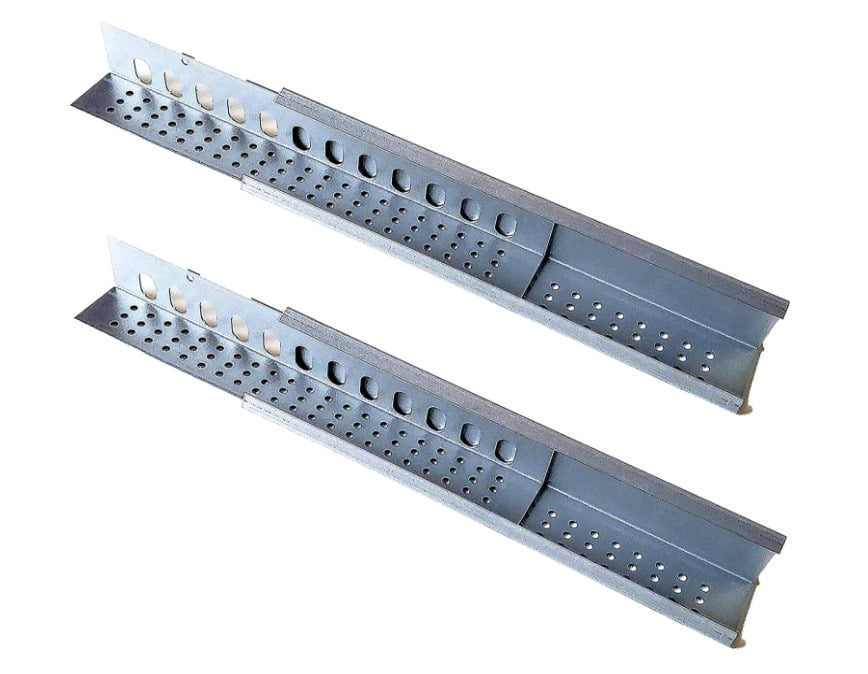

Winter is pretty hard on animals, and while we may not think about it much, honeybees and other insects have to survive the cold each year. Even if temperatures are freezing, honeybees can survive some pretty extreme temperatures and survive until spring comes. Amazingly, they can do it, so while we don’t see any of our honey-loving friends flying around during the winter, they are working very hard to stay warm.
While many people think that bees hibernate in winter, the truth is they don’t!
Bees are hardworking creatures who do not slow down when the cold weather rolls around. Instead of working hard to collect nectar and turn it into honey, the bees work day and night to keep the colony and nest warm enough to continue living.
Bees go into a state of semi-hibernation in order to conserve energy and preserve food supplies. The colony only needs to heat the brood (developing bees) which stays in their safe, warm environment as they hibernate.
Table of Contents
1. What Do Bees Do During The Winter?
2. How Do Bees Keep Their Nest Warm?
3. A Few Things Bees Do To Keep Their Cluster Warm
4. How Do Bees Go To The Bathroom?
5. Checking In Without Opening The Hive
6. What Do Beekeepers Do In The Winter For Their Bees?
Winter is pretty hard on animals, and while we may not think about it much, honeybees and other insects have to survive the cold each year. Even if temperatures are freezing, honeybees can survive some pretty extreme temperatures and survive until spring comes. Amazingly, they can do it, so while we don’t see any of our honey-loving friends flying around during the winter, they are working very hard to stay warm.
While many people think that bees hibernate in winter, the truth is they don’t!
Bees are hardworking creatures who do not slow down when the cold weather rolls around. Instead of working hard to collect nectar and turn it into honey, the bees work day and night to keep the colony and nest warm enough to continue living.
Bees go into a state of semi-hibernation in order to conserve energy and preserve food supplies. The colony only needs to heat the brood (developing bees) which stays in their safe, warm environment as they hibernate.
Table of Contents
1. What Do Bees Do During The Winter?
2. How Do Bees Keep Their Nest Warm?
3. A Few Things Bees Do To Keep Their Cluster Warm
4. How Do Bees Go To The Bathroom?
5. Checking In Without Opening The Hive
6. What Do Beekeepers Do In The Winter For Their Bees?
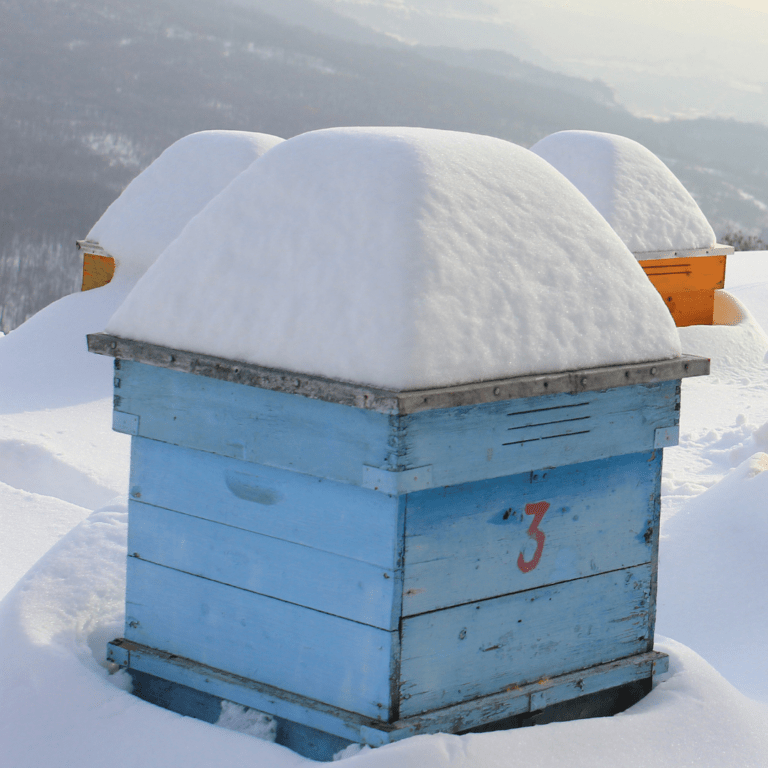
What Do Bees Do During The Winter?
Honeybees get cold just like we do, but they can’t turn on the heater to stay warm or throw on an extra jacket. During the winter, bees work together to stay warm inside their hive, keeping themselves, their queen, and their brood warm enough to survive the drop in temperature.
We may think that bees make honey for us to drizzle over our biscuits and pancakes, but I’m sorry to say, they don’t. They work day in and day out during the spring and summer, foraging your neighbor flowers for nectar so they can eat it during the winter. Honeybees (and many other bees, for that case) store away enough honey to survive the cold weather because there isn’t much blooming during the winter.

What Do Bees Do During The Winter?
Honeybees get cold just like we do, but they can’t turn on the heater to stay warm or throw on an extra jacket. During the winter, bees work together to stay warm inside their hive, keeping themselves, their queen, and their brood warm enough to survive the drop in temperature.
We may think that bees make honey for us to drizzle over our biscuits and pancakes, but I’m sorry to say, they don’t. They work day in and day out during the spring and summer, foraging your neighbor flowers for nectar so they can eat it during the winter. Honeybees (and many other bees, for that case) store away enough honey to survive the cold weather because there isn’t much blooming during the winter.
During the winter the lack of natural forage in the environment drops significant and beekeepers call this a nectar or honey dearth.
Bees can’t run down to the neighborhood garden for some nectar in December. So instead, they eat the nectar they turned into honey during April. The period where the bees are storing a lot of nectar is called a nectar flow or honey flow. Stored honey is like money in the bank for a bee colony. They use it to eat when it is literally too cold to fly.
But they aren’t just eating inside the colony; their real goal is to keep the queen and her eggs and brood warm. The queen slows down her egg-laying during the winter to make the job easier, but it is still a lot of work. They do this all winter long until the temperature warms up enough for flowers to start blooming and day-time highs to relieve the bees of this responsibility.
During the winter the lack of natural forage in the environment drops significant and beekeepers call this a nectar or honey dearth.
Bees can’t run down to the neighborhood garden for some nectar in December. So instead, they eat the nectar they turned into honey during April. The period where the bees are storing a lot of nectar is called a nectar flow or honey flow. Stored honey is like money in the bank for a bee colony. They use it to eat when it is literally too cold to fly.
But they aren’t just eating inside the colony; their real goal is to keep the queen and her eggs and brood warm. The queen slows down her egg-laying during the winter to make the job easier, but it is still a lot of work. They do this all winter long until the temperature warms up enough for flowers to start blooming and day-time highs to relieve the bees of this responsibility.
Honeybees keep their nest between 90°-95°F all
winter long, even when temperatures are in the
single digits outside.
Honeybees keep their nest between 90°-95°F all
winter long, even when temperatures are in the
single digits outside.
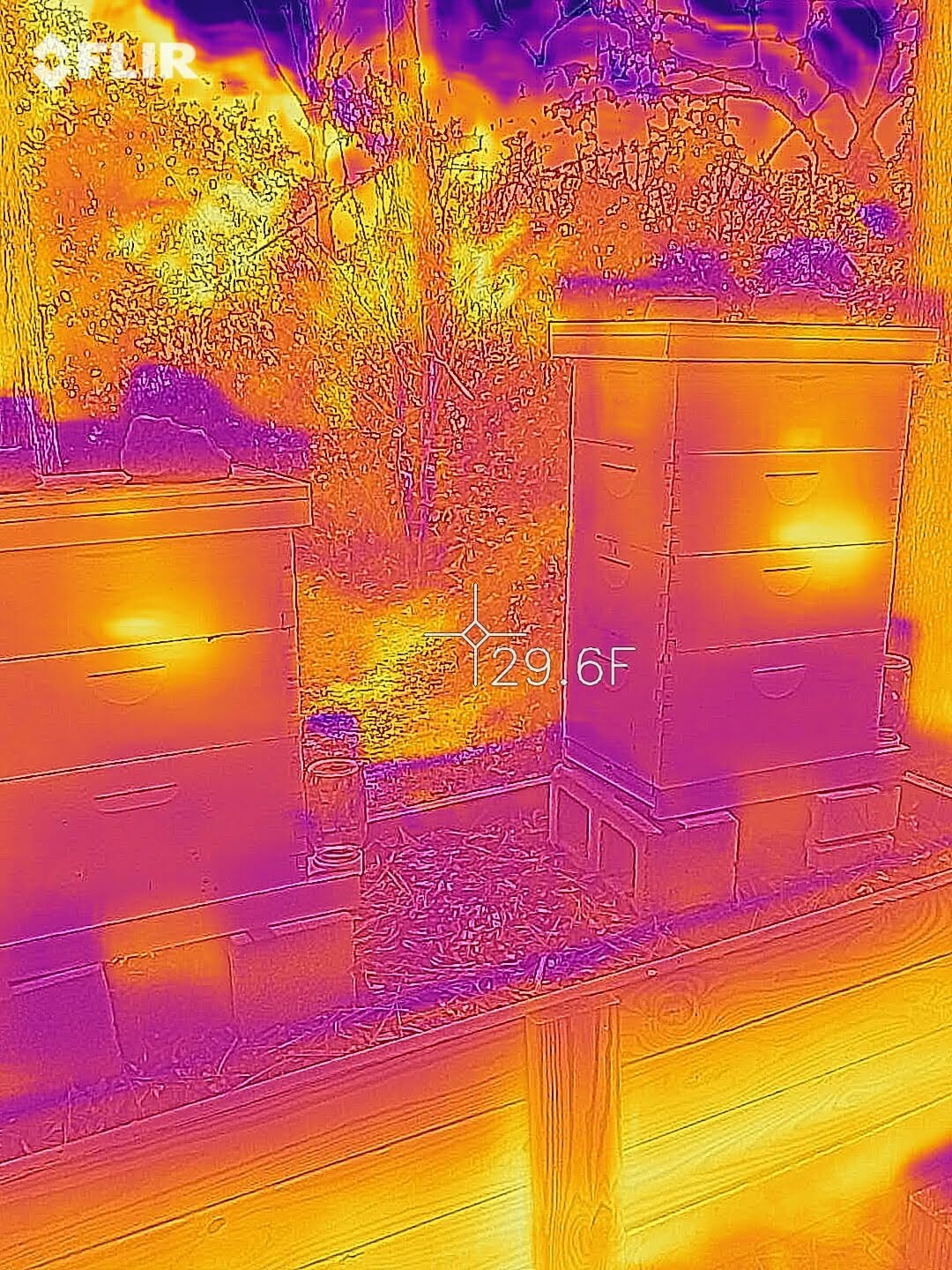
A thermal image of two beehives in sub-freezing temperatures. The purple is the coldest part of the hive in the bright orange core shows where the brood nest is.
How Do Bees Keep Their Nest Warm?
Honeybees are cavity dwellers who help their colony to survive the winter easier. Naturally, bees will choose to build their nest in a well-insulated cavity like a hollowed-out tree trunk. This extra insulation makes it a little easier for the colony to keep their brood warm enough to survive the cold.
But bees are not trying to keep their entire nest warm and don’t need to heat all their comb, pollen, and honey. They need to heat any eggs the queen has been laying until the bee hatches out. In addition to this, the bees need to keep themselves and their queen warm. They can’t just throw on another coat to stay warm, so they actually keep warm by vibrating.
Honeybees huddle together in a ball, which is what bees call the cluster. They do this to concentrate their heat and will cluster together into as tight a ball as necessary to stay warm. The colder it is outside, the tighter they have to group together. This can have some negative side effects, which I’ll touch on later.

A thermal image of two beehives in sub-freezing temperatures. The purple is the coldest part of the hive in the bright orange core shows where the brood nest is.
How Do Bees Keep Their Nest Warm?
Honeybees are cavity dwellers who help their colony to survive the winter easier. Naturally, bees will choose to build their nest in a well-insulated cavity like a hollowed-out tree trunk. This extra insulation makes it a little easier for the colony to keep their brood warm enough to survive the cold.
But bees are not trying to keep their entire nest warm and don’t need to heat all their comb, pollen, and honey. They need to heat any eggs the queen has been laying until the bee hatches out. In addition to this, the bees need to keep themselves and their queen warm. They can’t just throw on another coat to stay warm, so they actually keep warm by vibrating.
Honeybees huddle together in a ball, which is what bees call the cluster. They do this to concentrate their heat and will cluster together into as tight a ball as necessary to stay warm. The colder it is outside, the tighter they have to group together. This can have some negative side effects, which I’ll touch on later.
A Few Things Bees Do To Keep Their Cluster Warm
A Few Things Bees Do To Keep Their Cluster Warm
- When bees on the outside edge of the cluster get too cold, they swap places with the bees in the middle.
- Honeybees use the same muscle to fly to stay warm by vibrating it, but they unhinge their wing first, so they don’t fly.
- They consume honey to give them the energy to vibrate.
- They actually climb inside empty cells like it’s a sleeping bag to help concentrate heat.
- Bees actually perspire and create heat from their bodies.
- Bees seal any cracks inside the hive that let cold air in using propolis, a mixture they make from tree sap and enzymes.
- When bees on the outside edge of the cluster get too cold, they swap places with the bees in the middle.
- Honeybees use the same muscle to fly to stay warm by vibrating it, but they unhinge their wing first, so they don’t fly.
- They consume honey to give them the energy to vibrate.
- They actually climb inside empty cells like it’s a sleeping bag to help concentrate heat.
- Bees actually perspire and create heat from their bodies.
- Bees seal any cracks inside the hive that let cold air in using propolis, a mixture they make from tree sap and enzymes.
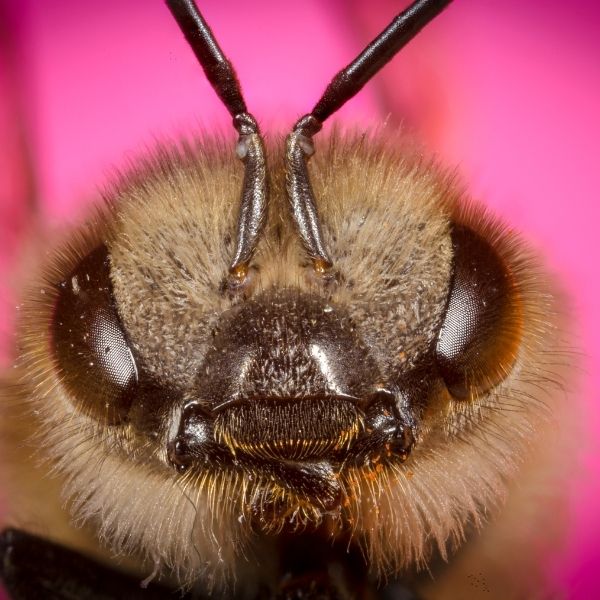
How Do Bees Go To The Bathroom?
So yes, bees actually do need to relieve themselves. It’s not really noticeable during the spring and summer, but bees do have to “go to the bathroom.” They don’t exactly have a bathroom; they go while they are flying. Beekeepers call this a “cleansing flight.” How delightful does that sound? Well, it’s not so delightful if you have a white car parked near a beehive. Little yellow streaks will start to appear on the car, and your nice BMW will turn into just a BM.
During cold weather (anything under 50°), the bees cannot fly and go on their “cleansing flight,” so they do what everyone has to do, hold it. The bees hold their bee’s knees together as long as they can’t until they can’t do it anymore. They don’t want to relieve themselves in the hives because bees like to keep a clean house, but they will if they can’t fly.

How Do Bees Go To The Bathroom?
So yes, bees actually do need to relieve themselves. It’s not really noticeable during the spring and summer, but bees do have to “go to the bathroom.” They don’t exactly have a bathroom; they go while they are flying. Beekeepers call this a “cleansing flight.” How delightful does that sound? Well, it’s not so delightful if you have a white car parked near a beehive. Little yellow streaks will start to appear on the car, and your nice BMW will turn into just a BM.
During cold weather (anything under 50°), the bees cannot fly and go on their “cleansing flight,” so they do what everyone has to do, hold it. The bees hold their bee’s knees together as long as they can’t until they can’t do it anymore. They don’t want to relieve themselves in the hives because bees like to keep a clean house, but they will if they can’t fly.
After a bought of cold weather, you’ll see some yellow streaks just outside the colony. It’s easier to see when the ground is covered in snow.
If your living right and the sun is just at the right angle, you might be able to catch a bee doing its business as it flies away. It’s somewhat cool, but it’s actually pretty gross. But not everyone gets to say they have seen a bee poop.
After a bought of cold weather, you’ll see some yellow streaks just outside the colony. It’s easier to see when the ground is covered in snow.
If your living right and the sun is just at the right angle, you might be able to catch a bee doing its business as it flies away. It’s somewhat cool, but it’s actually pretty gross. But not everyone gets to say they have seen a bee poop.
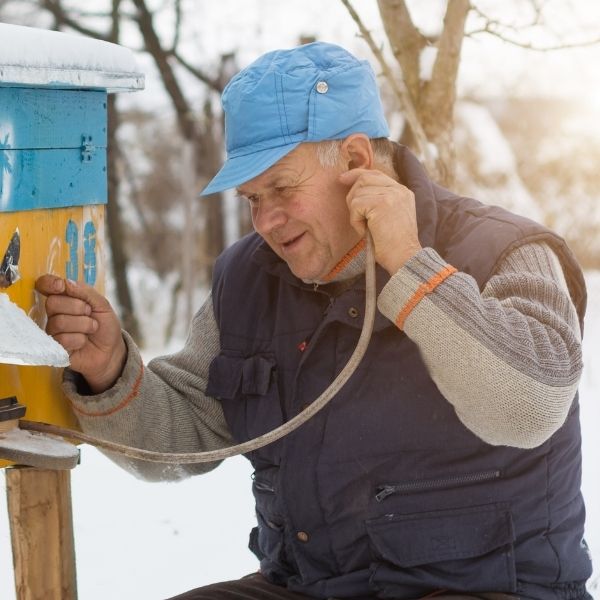
Checking In Without Opening The Hive
Beekeepers naturally want to see if their colony is still alive during all the cold weather. But the problem is that if a beekeeper opens the hive, they risk killing the colony they are trying to protect. It’s imperative that the hive stays closed during a cold front and freezing temperatures because it makes it difficult for the bees to keep the colony warm. But there are a few things beekeepers can do to check on the status of a colony (even though there isn’t much they can do to help).
- Use a thermal camera made by FLIR to inspect the colony for signs of warmth. Read more about how beekeepers use thermal cameras here.
- Give the side of the hive a tap with your knuckles and listen for buzzing. Don’t do this much as it causes the bees to use extra energy in response to the vibration. Having a stethoscope makes this easier.
- If you have a screened bottom board, you can climb under and look through the screen and up to the colony.
- If the hive has snow on it, as the colony perspires, the heat will actually melt some of the snow above the hole in the inner cover on the outside of the hive. You’ll see a circle of melted snow on the top of the hive.
- Look for any dead bees that are littered around the outside of the hive. It’s easy to see in the snow and is a sign the bees are cleaning the colony.

Checking In Without Opening The Hive
Beekeepers naturally want to see if their colony is still alive during all the cold weather. But the problem is that if a beekeeper opens the hive, they risk killing the colony they are trying to protect. It’s imperative that the hive stays closed during a cold front and freezing temperatures because it makes it difficult for the bees to keep the colony warm. But there are a few things beekeepers can do to check on the status of a colony (even though there isn’t much they can do to help).
- Use a thermal camera made by FLIR to inspect the colony for signs of warmth. Read more about how beekeepers use thermal cameras here.
- Give the side of the hive a tap with your knuckles and listen for buzzing. Don’t do this much as it causes the bees to use extra energy in response to the vibration. Having a stethoscope makes this easier.
- If you have a screened bottom board, you can climb under and look through the screen and up to the colony.
- If the hive has snow on it, as the colony perspires, the heat will actually melt some of the snow above the hole in the inner cover on the outside of the hive. You’ll see a circle of melted snow on the top of the hive.
- Look for any dead bees that are littered around the outside of the hive. It’s easy to see in the snow and is a sign the bees are cleaning the colony.
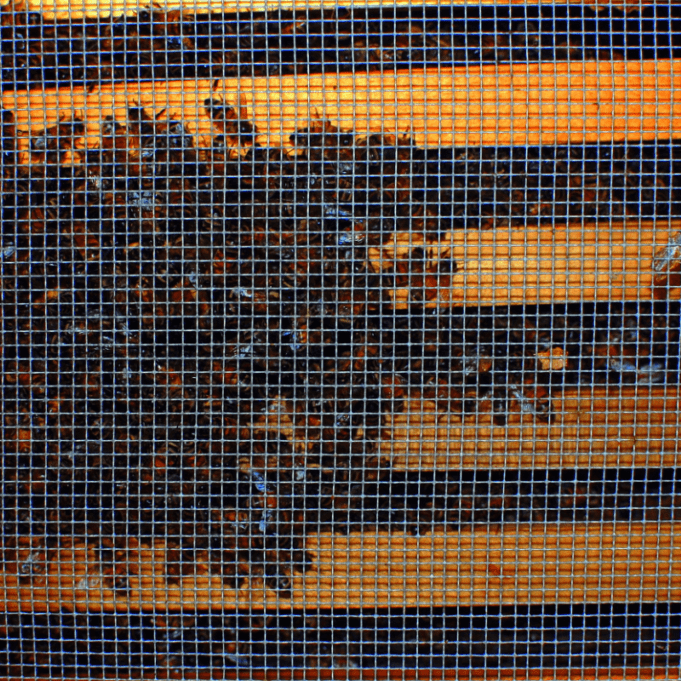
Looking at the cluster through a screened bottom board
What Do Beekeepers Do In The Winter For Their Bees?
So beekeepers can be in a tough situation because we are responsible for taking care of our bees. Beekeeping is a lot like taking care of livestock, so there are times when beekeepers need to do something to help. After all, we are placing our bees in artificial hives that are only 3/4-inch thick instead of inside a thick tree trunk.
The good news is that bees are pretty good at taking care of themselves during the winter. Cold is relative and quick cold front blasting though Texas doesn’t require the same amount of effort as a beekeeper in Wisconsin would need to take. Up north in the areas where there is a real winter, beekeepers act differently from Florida beekeepers with their “winter.”
It’s common for those northern beekeepers to add a little insulation to the outside of their hives during the winter to make life a little easier for their bees. Southern beekeepers don’t need to do this as southern winters are long or cold enough to warrant that extra effort. Most beekeepers in the south don’t need to do anything besides making sure there aren’t drafty holes in their equipment that let cold air or, worse, water in.

Looking at the cluster through a screened bottom board
What Do Beekeepers Do In The Winter For Their Bees?
So beekeepers can be in a tough situation because we are responsible for taking care of our bees. Beekeeping is a lot like taking care of livestock, so there are times when beekeepers need to do something to help. After all, we are placing our bees in artificial hives that are only 3/4-inch thick instead of inside a thick tree trunk.
The good news is that bees are pretty good at taking care of themselves during the winter. Cold is relative and quick cold front blasting though Texas doesn’t require the same amount of effort as a beekeeper in Wisconsin would need to take. Up north in the areas where there is a real winter, beekeepers act differently from Florida beekeepers with their “winter.”
It’s common for those northern beekeepers to add a little insulation to the outside of their hives during the winter to make life a little easier for their bees. Southern beekeepers don’t need to do this as southern winters are long or cold enough to warrant that extra effort. Most beekeepers in the south don’t need to do anything besides making sure there aren’t drafty holes in their equipment that let cold air or, worse, water in.
Cold weather usually wont kill a colony outright, but if bees get wet and cold, they are done for. Beekeepers need to keep their colonys free from moisture getting in to keep their bees dry.
Cold weather usually wont kill a colony outright, but if bees get wet and cold, they are done for. Beekeepers need to keep their colonys free from moisture getting in to keep their bees dry.
What Can A Beekeeper Do To Help Their Bees?
Beekeepers always want to do what they can to help their bees. Sometimes beekeepers tend to anthropomorphize (act like our bees feel and act how humans act) our bees, but it can sometimes hurt instead of helping them. This is seen a lot during the winter when beekeepers go out of their way to keep their colonies warm. The bees can do a great job of keeping warm without our help. Beekeepers will do everything from placing light bulbs in their hives to bringing the hives inside a building to keep it warm. There is a place for some of it, but it isn’t always necessary.
Here are a few things beekeepers can do to help their colonies survive the winter
- Seal and repair any cracks or openings in the colony besides the entrance and or screened bottom board; duct tape does wonders.
- Add a mouse guard to the entrance, not so much for the temperature but to keep any mice from making a nest inside to keep warm.
- Stop any prevailing winds from blowing onto the hives during the winter. This is only if there is a constant wind like on a lake.
- Tilting the colony forward or backward slightly will help any moisture that builds up inside the colony run down the hive’s edges instead of dripping back onto the bees.
- In extremely cold areas (think Kentucky north), wrapping a colony with some insulation can help. In the south, this isn’t necessary.
- If prevailing winds happen in your area, closing the screened bottom board with a tray can help.
- If necessary, feed bees dry sugar or fondant instead of liquid syrup during the winter. The syrup adds a lot of humidity to the inside of the hive.
What Can A Beekeeper Do To Help Their Bees?
Beekeepers always want to do what they can to help their bees. Sometimes beekeepers tend to anthropomorphize (act like our bees feel and act how humans act) our bees, but it can sometimes hurt instead of helping them. This is seen a lot during the winter when beekeepers go out of their way to keep their colonies warm. The bees can do a great job of keeping warm without our help. Beekeepers will do everything from placing light bulbs in their hives to bringing the hives inside a building to keep it warm. There is a place for some of it, but it isn’t always necessary.
Here are a few things beekeepers can do to help their colonies survive the winter
- Seal and repair any cracks or openings in the colony besides the entrance and or screened bottom board; duct tape does wonders.
- Add a mouse guard to the entrance, not so much for the temperature but to keep any mice from making a nest inside to keep warm.
- Stop any prevailing winds from blowing onto the hives during the winter. This is only if there is a constant wind like on a lake.
- Tilting the colony forward or backward slightly will help any moisture that builds up inside the colony run down the hive’s edges instead of dripping back onto the bees.
- In extremely cold areas (think Kentucky north), wrapping a colony with some insulation can help. In the south, this isn’t necessary.
- If prevailing winds happen in your area, closing the screened bottom board with a tray can help.
- If necessary, feed bees dry sugar or fondant instead of liquid syrup during the winter. The syrup adds a lot of humidity to the inside of the hive.
Should You Close The Screened Bottom Board During Winter
So this is something that comes up a lot. A screened bottom board is the most popular type of bottom board used. The alternative is a solid bottom board that works well but doesn’t have the same concerns as the screened bottom board during the winter. The screened bottom panel has a screen that allows air and debris to pass through it. The screen is excellent during the spring, summer, and fall, but what about the winter?
The real danger to bees during the winter is not the cold but is the moisture. An excess of humidity in the colony can kill a colony. Cold bees are fine, but cold and wet bees are dead bees. Because bees are reasonably well acclimated to the cold, the screened bottom board can be left open year-round.
The exception to this is in particularly windy areas or extremely cold regions. If I were a beekeeper in the northern US or Canada, I’d probably close up the screened bottom board with a tray of some type. The board or tray can either be slid under the screen if the bottom board is the necessary rails or slid in through the front on top of the screen. Both work fine.
But….. if you want to close it up as soon as September hits and you live in Tampa, that’s fine. If you’re going to leave it open all year and you live in Bismark, it’s probably fine too. It’s a beekeeper’s choice, and both options can work just fine. It’s not life or death (probably).
Should You Close The Screened Bottom Board During Winter
So this is something that comes up a lot. A screened bottom board is the most popular type of bottom board used. The alternative is a solid bottom board that works well but doesn’t have the same concerns as the screened bottom board during the winter. The screened bottom panel has a screen that allows air and debris to pass through it. The screen is excellent during the spring, summer, and fall, but what about the winter?
The real danger to bees during the winter is not the cold but is the moisture. An excess of humidity in the colony can kill a colony. Cold bees are fine, but cold and wet bees are dead bees. Because bees are reasonably well acclimated to the cold, the screened bottom board can be left open year-round.
The exception to this is in particularly windy areas or extremely cold regions. If I were a beekeeper in the northern US or Canada, I’d probably close up the screened bottom board with a tray of some type. The board or tray can either be slid under the screen if the bottom board is the necessary rails or slid in through the front on top of the screen. Both work fine.
But….. if you want to close it up as soon as September hits and you live in Tampa, that’s fine. If you’re going to leave it open all year and you live in Bismark, it’s probably fine too. It’s a beekeeper’s choice, and both options can work just fine. It’s not life or death (probably).
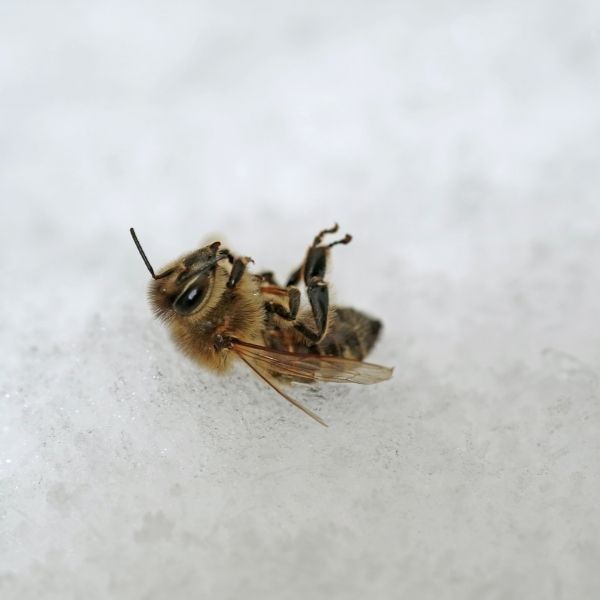
A single dead worker bee in the snow
What Happens After A Cold Front Is Over
Besides taking a leak outside, the bees may have to clean up any of the bees that died during the cold front. Bees do a great job at keeping their nest warm as long as they have enough worker bees to get the job done. The queen is laying all those eggs during the winter which are the next generation of worker bees.
When the queen lays all those eggs, she does it in a uniform pattern which makes it easier for the worker bees to keep them warm. Where the cluster forms correspond exactly to the area where the queen has been laying eggs.
Sometimes the queen will get ahead of herself and lay too many eggs for the time of the year. The queen actually restricts the number of eggs she lays during the winter, but ramps back up in the late winter early spring. She does this so there are plenty of worker bees to make the most of the spring bloom.
When the queen gets ahead of herself and a cold front comes in, there is a really good chance some of the eggs she lays will get too cold to survive. When there aren’t enough adult bees to keep the eggs and larva warm, the brood on the edges will die.

A single dead worker bee in the snow
What Happens After A Cold Front Is Over
Besides taking a leak outside, the bees may have to clean up any of the bees that died during the cold front. Bees do a great job at keeping their nest warm as long as they have enough worker bees to get the job done. The queen is laying all those eggs during the winter which are the next generation of worker bees.
When the queen lays all those eggs, she does it in a uniform pattern which makes it easier for the worker bees to keep them warm. Where the cluster forms correspond exactly to the area where the queen has been laying eggs.
Sometimes the queen will get ahead of herself and lay too many eggs for the time of the year. The queen actually restricts the number of eggs she lays during the winter, but ramps back up in the late winter early spring. She does this so there are plenty of worker bees to make the most of the spring bloom.
When the queen gets ahead of herself and a cold front comes in, there is a really good chance some of the eggs she lays will get too cold to survive. When there aren’t enough adult bees to keep the eggs and larva warm, the brood on the edges will die.
Chilled brood is the term beekeepers use when the outside edges of the brood nest get too cold to survive and die. Worker bees will sacrifice the edges of the brood so the center of the brood nest stays warm.
Chilled brood is the term beekeepers use when the outside edges of the brood nest get too cold to survive and die. Worker bees will sacrifice the edges of the brood so the center of the brood nest stays warm.
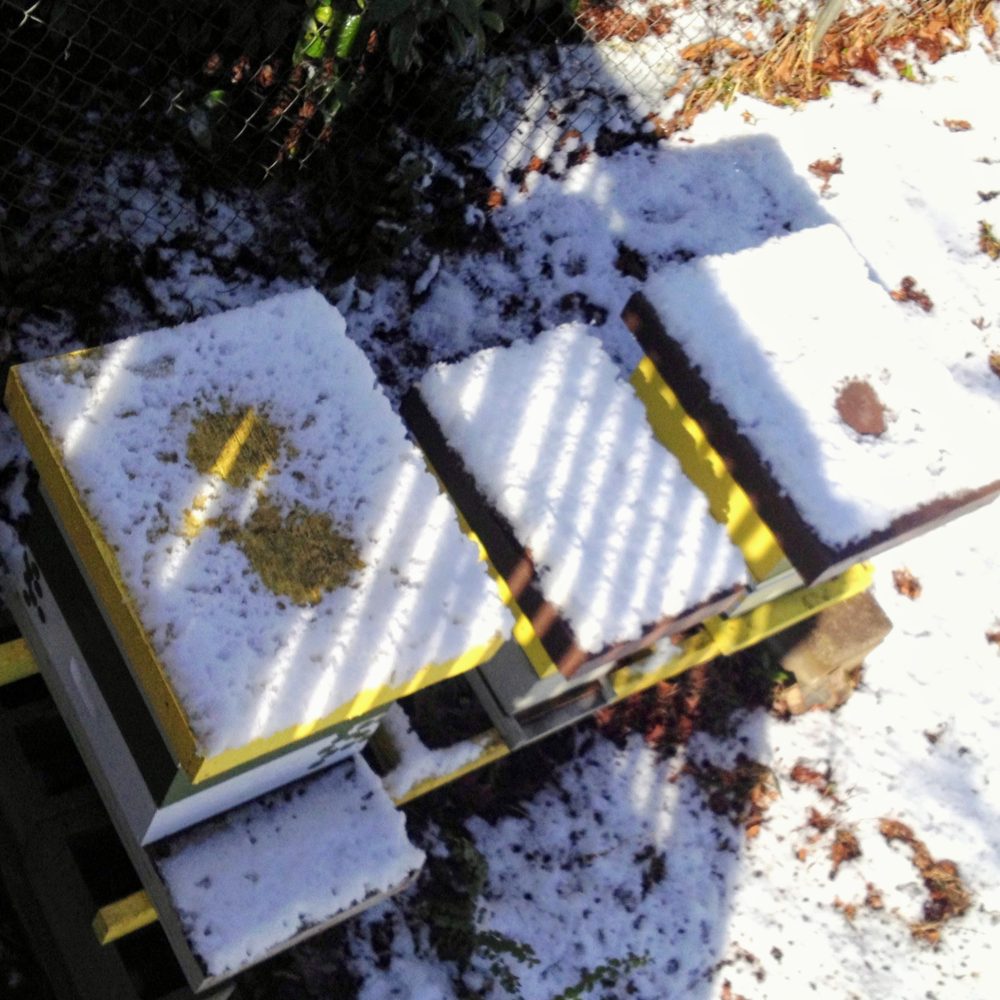
Melted snow from the bees heat on top of hive
During a cold front, the bees cannot clean out their hive, and the “chores” have started to pile up. Honeybees like a very clean interior hive and work hard to keep it that way by constantly cleaning it out. Because of this, beekeepers should expect to see more dead bees just outside the front of their colony. It is such an expected activity that if I didn’t see this after a cold front in the winter, I would be concerned something was wrong.
Because of this, beekeepers should expect to see more dead bees just outside the front of their colony. It is such an expected activity that if I didn’t see this after a cold front in the winter, I would be concerned something was wrong. So beekeepers should be looking for dead bees outside their colony on the first day above 50°F after a cold front.
Better yet, beekeepers should be looking for living bees dragging out dead bees from inside the hive. You’ll see this because older bees who couldn’t survive the cold drop down away from the cluster but remain in the hive. They remain there until the weather warms enough for the cleaner bees to remove them and drop them outside the hive.

Melted snow from the bees heat on top of hive
During a cold front, the bees cannot clean out their hive, and the “chores” have started to pile up. Honeybees like a very clean interior hive and work hard to keep it that way by constantly cleaning it out. Because of this, beekeepers should expect to see more dead bees just outside the front of their colony. It is such an expected activity that if I didn’t see this after a cold front in the winter, I would be concerned something was wrong.
Because of this, beekeepers should expect to see more dead bees just outside the front of their colony. It is such an expected activity that if I didn’t see this after a cold front in the winter, I would be concerned something was wrong. So beekeepers should be looking for dead bees outside their colony on the first day above 50°F after a cold front.
Better yet, beekeepers should be looking for living bees dragging out dead bees from inside the hive. You’ll see this because older bees who couldn’t survive the cold drop down away from the cluster but remain in the hive. They remain there until the weather warms enough for the cleaner bees to remove them and drop them outside the hive.
Chilled Brood Cleanup
Chilled Brood Cleanup
If the cold front was particularly late in winter, depending on your climate, this could be February through April; you’ll see signs of the chilled brood. This is pretty easy to identify because, in addition to seeing dead adults in front of the colony, you’ll also see dead white bee larva in the front too. This is because the bees don’t want the dead larva in the cells and want to clean them out so the queen can lay another egg in that cell.
It’s really pretty amazing to see this all happening. But if you do see it happen, you can feel good the bees are doing their job and will survive the winter.
If the cold front was particularly late in winter, depending on your climate, this could be February through April; you’ll see signs of the chilled brood. This is pretty easy to identify because, in addition to seeing dead adults in front of the colony, you’ll also see dead white bee larva in the front too. This is because the bees don’t want the dead larva in the cells and want to clean them out so the queen can lay another egg in that cell.
It’s really pretty amazing to see this all happening. But if you do see it happen, you can feel good the bees are doing their job and will survive the winter.



